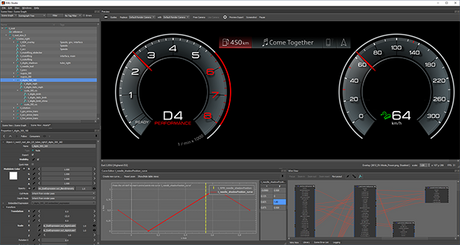The work of the Technical Artists includes the detailed analysis of the customer's design wishes described in a specification and expressed in 2D graphics. Specifically, we think about the technical implementation, for example, into which elements a tachometer must be divided (scale, digits, needle, background, ...) and then execute them so that the instrument behaves as specified in every desired situation (start-up animation, performance-dependent effects, layout switching).
We create and edit the so-called graphic assets in our own 3D development environment "ESEL-Studio", which is tailored to our needs and thanks to our regular feedback is always being developed further. You can think of it like Unity or Unreal Editor. This is where we Technical Artists bring all the elements - textures, 3D meshes and shaders - together and bring them to life. The textures are mostly prepared using Adobe Photoshop. For 3D modeling, you can use whatever suits you - most of the team prefer Blender, but Modo and Houdini specialists also get their money's worth. Behavioral logic is introduced in the engine's own imperative language. Thanks to GLSL shader magic, the development of which will take up a larger part of your work time, you are not limited to using RGBA texture channels, vertex colors or vertex positions in a conventional way, but can otherwise fill them with only the most necessary values. This is necessary to make the best use of the often not very powerful hardware installed in the vehicle and to guarantee a smooth rendering.
To ensure that each graphic asset fits smoothly into the overall system, we are in close contact with the application developers. Together with them, we consider which functions are best left to whom and work out common interfaces. After completion, the application and graphic asset parts end up in one software on the target, the instrument cluster or so-called main unit, which is installed in the car. Before we integrate our work into the main development branch via Perforce or Git and hand it over to the test department, we check it ourselves on the targets available to us, at the workstation or directly in the vehicle.
Everyone has different preferences and approaches, and every now and then we need very specific tools and scripts to make our work easier. We write these ourselves, be it as Photoshop actions, in Python or other suitable languages, and present them to our colleagues in regular tech talks. In addition, we exchange information about the status of our various projects every week and thus always learn new interesting things.
